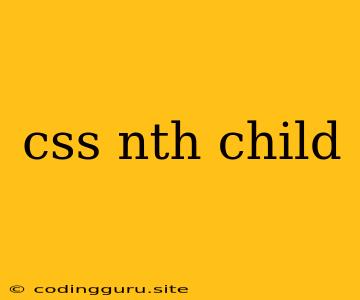Mastering CSS nth-child Selector: Styling Specific Elements with Ease
Styling web pages often involves targeting specific elements based on their position within a larger group. The CSS nth-child selector provides a powerful and flexible way to accomplish this, offering a streamlined approach to manipulating the appearance of elements within a list or collection.
What is the nth-child selector?
The nth-child selector in CSS allows you to select specific elements within a parent container based on their position relative to their siblings. It uses a formula to specify which elements should be targeted, giving you a wide range of control over styling.
How does nth-child work?
The nth-child selector uses a formula that determines which elements to select based on their order within a parent element. This formula can take various forms, including:
nth-child(n): Selects every nth child element, where 'n' is a number.nth-child(even): Selects all even-numbered child elements.nth-child(odd): Selects all odd-numbered child elements.nth-child(an + b): Selects elements where their index satisfies the equation 'an + b'. 'a' and 'b' are integers.
Common Use Cases of nth-child
The nth-child selector proves incredibly useful in a multitude of web design scenarios:
- Alternating Row Colors: Create visually appealing tables or lists by alternating the background color of rows.
- Highlighting Every Other Item: Emphasize specific items in a list or gallery by changing their color, font size, or border.
- Styling Navigation Menus: Apply distinct styles to every other navigation link for a visually appealing effect.
- Creating Striped Patterns: Generate visually interesting patterns within layouts by alternating colors or styles on specific elements.
Examples of nth-child in Action
Let's explore some practical examples of how nth-child can be used in CSS:
1. Alternating Row Colors in a Table
table tr:nth-child(even) {
background-color: lightgray;
}
This code snippet will apply a light gray background color to every even-numbered row within a table.
2. Highlighting Every Third Item in a List
ul li:nth-child(3n) {
font-weight: bold;
}
This example will make every third list item within the <ul> element bold.
3. Styling Navigation Links
nav ul li:nth-child(odd) a {
color: blue;
}
nav ul li:nth-child(even) a {
color: red;
}
This code will alternate the color of navigation links, making odd-numbered links blue and even-numbered links red.
4. Creating a Striped Pattern
div.container div:nth-child(even) {
background-color: lightblue;
}
This example will create a striped pattern by applying a light blue background color to every even-numbered <div> element within a container.
Advanced nth-child Techniques
nth-of-type: Similar tonth-child,nth-of-typetargets elements based on their position, but only considers elements of a specific type. For instance,li:nth-of-type(2)will select the second<li>element within its parent, regardless of other child elements.nth-last-child: This selector selects elements based on their position from the end of a list rather than the beginning.nth-last-of-type: Similar tonth-last-child, this selector targets elements of a specific type based on their position from the end of the list.
Conclusion
The CSS nth-child selector is a powerful tool that provides developers with precise control over element styling based on their position within a group. By mastering the various formulas and techniques, you can create visually appealing and dynamic web pages that are both functional and aesthetically pleasing.
